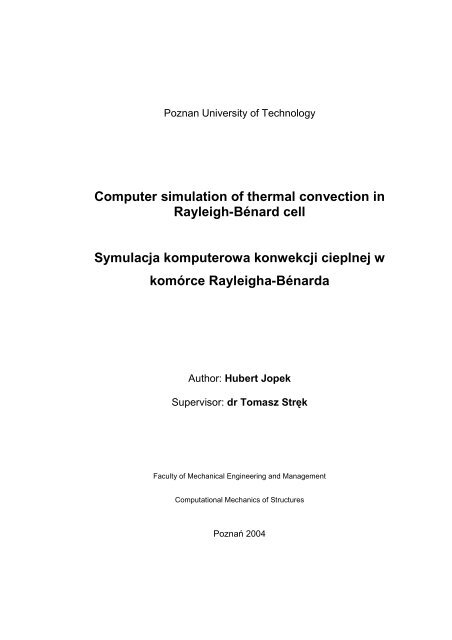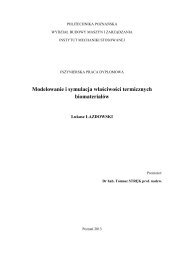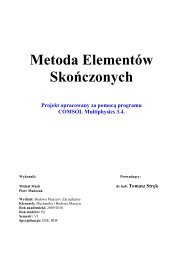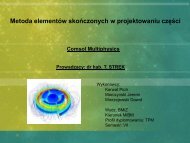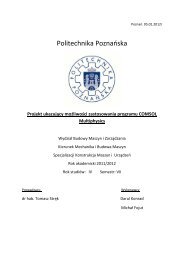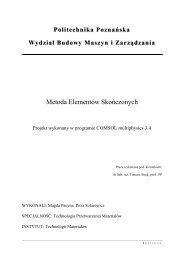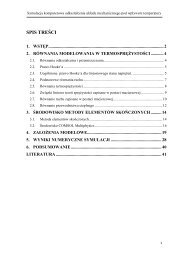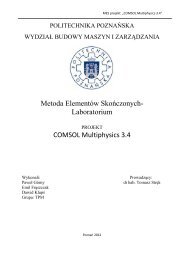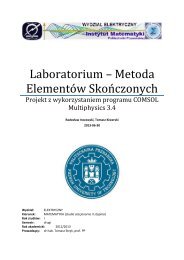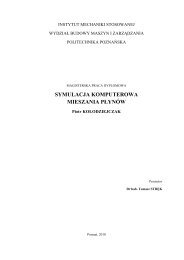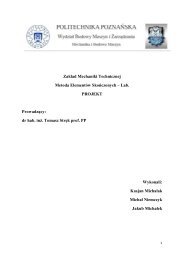Computer simulation of thermal convection in Rayleigh-Bénard cell ...
Computer simulation of thermal convection in Rayleigh-Bénard cell ...
Computer simulation of thermal convection in Rayleigh-Bénard cell ...
You also want an ePaper? Increase the reach of your titles
YUMPU automatically turns print PDFs into web optimized ePapers that Google loves.
Poznan University <strong>of</strong> Technology<br />
<strong>Computer</strong> <strong>simulation</strong> <strong>of</strong> <strong>thermal</strong> <strong>convection</strong> <strong>in</strong><br />
<strong>Rayleigh</strong>-<strong>Bénard</strong> <strong>cell</strong><br />
Symulacja komputerowa konwekcji cieplnej w<br />
komórce <strong>Rayleigh</strong>a-<strong>Bénard</strong>a<br />
Author: Hubert Jopek<br />
Supervisor: dr Tomasz Stręk<br />
Faculty <strong>of</strong> Mechanical Eng<strong>in</strong>eer<strong>in</strong>g and Management<br />
Computational Mechanics <strong>of</strong> Structures<br />
Poznań 2004
Hubert Jopek<br />
<strong>Computer</strong> <strong>simulation</strong> <strong>of</strong> <strong>thermal</strong> <strong>convection</strong> <strong>in</strong> <strong>Rayleigh</strong>-<strong>Bénard</strong> <strong>cell</strong><br />
Contents<br />
1. Abstracts .........................................................................................<br />
1.1. Abstract ........................................................................<br />
1.2. Polish abstract (streszczenie) ....................................................<br />
2. Introduction .....................................................................................<br />
2.1. <strong>Rayleigh</strong>-<strong>Bénard</strong> <strong>convection</strong> ....................................................<br />
2.2. Objective and layout .................................................................<br />
3. Description <strong>of</strong> the geometry <strong>in</strong> <strong>Rayleigh</strong>-<strong>Bénard</strong> model ..................<br />
4. The <strong>Rayleigh</strong> number ......................................................................<br />
5. Govern<strong>in</strong>g equations .......................................................................<br />
5.1. Introduc<strong>in</strong>g dimensionless variables ........................................<br />
5.2. The streamfunction representation <strong>of</strong> equations ......................<br />
5.3. Fourier expansion <strong>of</strong> the streamfunction ..................................<br />
5.4. Boundary conditions .................................................................<br />
5.5. The Lorenz model <strong>of</strong> <strong>convection</strong> ..............................................<br />
6. <strong>Computer</strong> <strong>simulation</strong> .......................................................................<br />
6.1. Oscillatory motion .....................................................................<br />
6.2. Chaotic behaviour <strong>of</strong> fluid .........................................................<br />
6.3. Numerical accuracy analysis ...................................................<br />
6.4. CFD s<strong>of</strong>tware <strong>simulation</strong> ..........................................................<br />
7. Pattern formation ............................................................................<br />
8. Conclusions ....................................................................................<br />
Appendix A – fluid properties ........................................................……<br />
Appendix B – program list<strong>in</strong>g .....................................................….…..<br />
References .................................................................................……...<br />
2<br />
3<br />
4<br />
4<br />
6<br />
7<br />
8<br />
11<br />
15<br />
18<br />
20<br />
21<br />
22<br />
25<br />
26<br />
28<br />
32<br />
34<br />
36<br />
38<br />
39<br />
43<br />
45<br />
2
Hubert Jopek<br />
<strong>Computer</strong> <strong>simulation</strong> <strong>of</strong> <strong>thermal</strong> <strong>convection</strong> <strong>in</strong> <strong>Rayleigh</strong>-<strong>Bénard</strong> <strong>cell</strong><br />
Chapter 1: Abstracts<br />
1.1. Abstract<br />
In this work the <strong>thermal</strong> <strong>convection</strong> phenomena, which occur <strong>in</strong> the twodimensional<br />
th<strong>in</strong> layer <strong>of</strong> fluid <strong>of</strong> <strong>in</strong>f<strong>in</strong>ite length. The layer is heated from below and<br />
simultaneously cooled at the top as a result the particles <strong>of</strong> the fluid beg<strong>in</strong> to move<br />
creat<strong>in</strong>g <strong>convection</strong>al rolls. These phenomena are known as <strong>Rayleigh</strong>-<strong>Bénard</strong><br />
<strong>convection</strong>. This problem is fully described by the couple <strong>of</strong> partial differential<br />
equations i.e. the Navier-Stokes equation and the <strong>thermal</strong> diffusion equation. These<br />
equations were transformed <strong>in</strong>to the system <strong>of</strong> three ord<strong>in</strong>ary differential equations<br />
well-known as the Lorenz model. This model is very useful <strong>in</strong> study<strong>in</strong>g the chaotic<br />
behaviour <strong>of</strong> the fluid which occurs <strong>in</strong> described phenomena. The Lorenz model was<br />
used to carry out the computer <strong>simulation</strong> <strong>of</strong> <strong>convection</strong> show<strong>in</strong>g the fluid behaviour<br />
with respect to different parameters. The results were compared with the <strong>simulation</strong><br />
form the fluid dynamics program. Because <strong>of</strong> the fact that numerical calculation is<br />
never precise there was the analysis made which shows how the accuracy <strong>of</strong><br />
calculation changes the result. F<strong>in</strong>ally the pattern formation <strong>in</strong> convective fluid is<br />
described. This behaviour is characteristic for self-organized systems which manifest<br />
the ordered structure <strong>in</strong> the state far from equilibrium.<br />
3
Hubert Jopek<br />
<strong>Computer</strong> <strong>simulation</strong> <strong>of</strong> <strong>thermal</strong> <strong>convection</strong> <strong>in</strong> <strong>Rayleigh</strong>-<strong>Bénard</strong> <strong>cell</strong><br />
1.2. Polish abstract (streszczenie)<br />
W pracy zaprezentowane zostało zjawisko konwekcji cieplnej zachodzącej w<br />
cienkiej dwuwymiarowej warstwie płynu, o nieskończonej długości. Warstwa ta jest<br />
podgrzewana od dołu i jednocześnie chłodzona od góry, w efekcie cząsteczki płynu<br />
zaczynają się poruszać tworząc tzw. rolki konwekcyjne. Zjawisko to powszechnie<br />
znane jest jako konwekcja <strong>Rayleigh</strong>a-<strong>Bénard</strong>a. Układ Opisany jest przy uŜyciu<br />
cząstkowych równań róŜniczkowych: równania Naviera-Stokesa oraz równanie<br />
przewodnictwa ciepła. Przekształcenie tych równań oraz dzięki zastosowanie<br />
rozw<strong>in</strong>ięcia w szereg Fouriera przy pewnych załoŜeniach prowadzi do modelu<br />
opisanego za pomocą trzech zwyczajnych równań róŜniczkowych znanych<br />
powszechnie jako układ Lorenza. Układ ten umoŜliwia analizę chaotycznego<br />
zachowania płynu, jakie zachodzi w omawianym zjawisku. Model Lorenza został<br />
wykorzystany do przeprowadzenia symulacji komputerowej konwekcji prezentującej<br />
zachowanie się płynu dla róŜnych parametrów. Wyniki porównano z symulacją<br />
konwekcji otrzymaną z programu słuŜącego do analizy dynamiki płynów. PoniewaŜ<br />
obliczenia numeryczne obarczone są zawsze błędem związanym z zastosowaną<br />
metodą obliczeń przedstawiony równieŜ został wpływ, jaki ma precyzja<br />
wykonywanych obliczeń na uzyskane wyniki. Ponadto przedstawione zostało<br />
zjawisko tworzenia się regularnego wzoru, które towarzyszy konwekcji <strong>Rayleigh</strong>a-<br />
<strong>Bénard</strong>a. Takie zachowanie charakterystyczne jest dla systemów<br />
samoorganizujących się, które zachowują się w sposób uporządkowany będąc w<br />
stanie dalekim od równowagi.<br />
4
Hubert Jopek<br />
<strong>Computer</strong> <strong>simulation</strong> <strong>of</strong> <strong>thermal</strong> <strong>convection</strong> <strong>in</strong> <strong>Rayleigh</strong>-<strong>Bénard</strong> <strong>cell</strong><br />
Chapter 2: Introduction<br />
2.1. <strong>Rayleigh</strong>-<strong>Bénard</strong> Convection<br />
The <strong>Rayleigh</strong>-<strong>Bénard</strong> <strong>convection</strong> is a problem which has been studied for<br />
over a century and it's still a very <strong>in</strong>terest<strong>in</strong>g problem for many researchers all over<br />
the world, and it's used e.g. <strong>in</strong> astrophysics, geophysics, and atmospheric<br />
sciences [8]. This theory is very useful <strong>in</strong> describ<strong>in</strong>g weather phenomena and<br />
long-term climatic effects [11]; consequently there are many applications which are<br />
based on this theory, such as Solar Energy systems (e.g. Power Tower) [10], energy<br />
storage and material process<strong>in</strong>g. Not only for its practical significance is this problem<br />
so important, but also for purely theoretical reasons as well. The <strong>Rayleigh</strong>-<strong>Bénard</strong><br />
<strong>convection</strong> model is an <strong>in</strong>f<strong>in</strong>ite, th<strong>in</strong> layer <strong>of</strong> fluid (practically a very long). The fluid is<br />
heated from below while the top one stays colder. The temperature gradient is<br />
crucial for the problem: if it's below a certa<strong>in</strong> value, the fluid stays stable despite its<br />
natural tendency to move because <strong>of</strong> its viscosity and <strong>thermal</strong> diffusivity. On the<br />
other hand, when the temperature gradient is over the critical value <strong>thermal</strong><br />
<strong>in</strong>stability occurs. The men who first considered the problem at the beg<strong>in</strong>n<strong>in</strong>g <strong>of</strong> 20 th<br />
century were <strong>Rayleigh</strong> and <strong>Bénard</strong>, the former provided some theoretical basis for<br />
the <strong>convection</strong> phenomena, while the latter executed some experiments <strong>in</strong> order to<br />
demonstrate the onset <strong>of</strong> <strong>thermal</strong> <strong>in</strong>stability. The phenomena <strong>of</strong> <strong>thermal</strong> <strong>convection</strong><br />
were called the <strong>Rayleigh</strong>-<strong>Bénard</strong> <strong>convection</strong> <strong>in</strong> their honour. However, there is a<br />
difference between their attitudes to the problem. <strong>Bénard</strong>'s researches concerned<br />
the <strong>in</strong>stability caused by the temperature dependence <strong>of</strong> the surface-tension<br />
coefficient whereas <strong>Rayleigh</strong> was <strong>in</strong>terested <strong>in</strong> the <strong>convection</strong> which occurs and<br />
arises as a result <strong>of</strong> temperature and density nonuniformity. At present, the<br />
mechanism studied by <strong>Rayleigh</strong> is called the <strong>Rayleigh</strong>-<strong>Bénard</strong> <strong>convection</strong> while<br />
thermocapillary <strong>convection</strong> is called <strong>Bénard</strong>-Marangoni <strong>convection</strong>.<br />
5
Hubert Jopek<br />
<strong>Computer</strong> <strong>simulation</strong> <strong>of</strong> <strong>thermal</strong> <strong>convection</strong> <strong>in</strong> <strong>Rayleigh</strong>-<strong>Bénard</strong> <strong>cell</strong><br />
The mathematical model <strong>of</strong> this problem is set <strong>of</strong> non-l<strong>in</strong>ear coupled partial<br />
differential equations and the solution <strong>of</strong> this set is degenerate and non-unique [2].<br />
This model is an example <strong>of</strong> a non-l<strong>in</strong>ear system and it can provide an <strong>in</strong>sight <strong>in</strong>to<br />
nonl<strong>in</strong>ear phenomena studies. Another property <strong>of</strong> the <strong>Rayleigh</strong>-<strong>Bénard</strong> system is its<br />
time dependence, which seems to be one <strong>of</strong> the most important aspects <strong>of</strong> transition<br />
from lam<strong>in</strong>ar to turbulent flow [6]. It is believed that the <strong>Rayleigh</strong>-<strong>Bénard</strong> system is a<br />
very important part <strong>of</strong> low-dimensional and spatiotemporal chaos theories and, what<br />
is more, it's also a canonical example <strong>of</strong> a cont<strong>in</strong>uous system which is able to<br />
generate and susta<strong>in</strong> spatiotemporal chaos [4]. The system is also an example <strong>of</strong><br />
self-organization (a pattern form<strong>in</strong>g system) which makes it the most carefully<br />
studied system <strong>of</strong> this k<strong>in</strong>d. Particularly synergetic specialists are <strong>in</strong>terested <strong>in</strong> this<br />
system because it's possible to observe some essential features for nonl<strong>in</strong>ear<br />
pattern-form<strong>in</strong>g process [9]. Such formations <strong>of</strong> patterns occur <strong>in</strong> crystal growth,<br />
solidification fronts' propagation <strong>in</strong>stabilities <strong>of</strong> nematic liquid crystal, buckl<strong>in</strong>g <strong>of</strong> th<strong>in</strong><br />
plates and shells, etc. It's also possible to observe them <strong>in</strong> sand ripples on beaches<br />
and desert; <strong>in</strong> geological formations, <strong>in</strong> <strong>in</strong>teract<strong>in</strong>g laser beams, and <strong>in</strong>stabilities <strong>of</strong><br />
numerical algorithms.<br />
6
Hubert Jopek<br />
<strong>Computer</strong> <strong>simulation</strong> <strong>of</strong> <strong>thermal</strong> <strong>convection</strong> <strong>in</strong> <strong>Rayleigh</strong>-<strong>Bénard</strong> <strong>cell</strong><br />
2.2. Objective and layout<br />
The ma<strong>in</strong> objective <strong>of</strong> this work is to create a simplified model <strong>of</strong> <strong>Rayleigh</strong>-<br />
<strong>Bénard</strong> <strong>convection</strong> us<strong>in</strong>g the famous Lorenz differential equations system i.e.<br />
Mathematica. Hav<strong>in</strong>g this model done it will be simulated us<strong>in</strong>g symbolic algebra<br />
system. The <strong>simulation</strong> will be connected with the discussion <strong>of</strong> the results. F<strong>in</strong>ally<br />
another computer <strong>simulation</strong> will be done us<strong>in</strong>g fluid dynamics s<strong>of</strong>tware and the<br />
result <strong>of</strong> this <strong>simulation</strong> will be compared with the previous one.<br />
Firstly the geometry <strong>of</strong> the <strong>Rayleigh</strong>-<strong>Bénard</strong> <strong>convection</strong> model is presented <strong>in</strong><br />
the third chapter, also the transition from <strong>thermal</strong> conduction to <strong>convection</strong> is shown.<br />
The next chapter is the <strong>in</strong>troduction <strong>of</strong> the dimensionless constant i.e. the <strong>Rayleigh</strong><br />
number which is an essential parameter <strong>of</strong> the description <strong>of</strong> considered model. The<br />
fifth chapter conta<strong>in</strong>s the full formal description <strong>of</strong> <strong>convection</strong>. Standard equations <strong>of</strong><br />
fluid mechanics and <strong>thermal</strong> energy diffusion are transformed to the well-known<br />
Lorenz model <strong>of</strong> <strong>convection</strong>. The chapter number six is the presentation <strong>of</strong> the<br />
computer <strong>simulation</strong> <strong>of</strong> the <strong>convection</strong>. Both Lorenz model <strong>of</strong> <strong>convection</strong>, and the<br />
CFD s<strong>of</strong>tware results are shown. In addition to this, small discussion about<br />
numerical precision is carried out. The next chapter is the description <strong>of</strong> the pattern<br />
formation phenomenon and the <strong>Rayleigh</strong>-<strong>Bénard</strong> <strong>convection</strong> is presented as an<br />
example <strong>of</strong> the self-organized system. F<strong>in</strong>ally some conclusions are given <strong>in</strong> the<br />
n<strong>in</strong>th chapter. At the end <strong>of</strong> the work there are two appendix, where the former is the<br />
table <strong>of</strong> standard fluid properties while the latter is the list<strong>in</strong>g <strong>of</strong> the program code.<br />
7
Hubert Jopek<br />
<strong>Computer</strong> <strong>simulation</strong> <strong>of</strong> <strong>thermal</strong> <strong>convection</strong> <strong>in</strong> <strong>Rayleigh</strong>-<strong>Bénard</strong> <strong>cell</strong><br />
Chapter 3: Description <strong>of</strong> the geometry <strong>in</strong> <strong>Rayleigh</strong>-<strong>Bénard</strong> model<br />
The Geometry <strong>of</strong> the <strong>Rayleigh</strong>-<strong>Bénard</strong> model is presented below:<br />
Fig. 3.1: The fluid layer model.<br />
the top<br />
The model is a very long narrow fluid layer. There are fixed temperatures at<br />
T<br />
C<br />
and at the bottom<br />
Tw<br />
and the temperature at the bottom is higher so<br />
T<br />
w<br />
> T c<br />
. The difference <strong>of</strong> the temperature is expressed by the term δT<br />
= T w<br />
−Tc<br />
this is one <strong>of</strong> the control parameters <strong>of</strong> the system. Convection appears when the<br />
temperature gradient is big enough, consequently a small packet <strong>of</strong> fluid starts to<br />
move up <strong>in</strong>to the colder region <strong>of</strong> higher density. If the buoyant force caused by<br />
difference <strong>of</strong> density is big enough, then the pocket moves upward so fast that the<br />
temperature cannot drop and the convective flow appears. There is also possible<br />
that the buoyant force is not strong enough, <strong>in</strong> such a situation the temperature <strong>of</strong><br />
the pocket is able to drop before it can move up too much, and as a result fluid stays<br />
stable.<br />
and<br />
Fig. 3.2: Transition from <strong>thermal</strong> conduction to convective rolls <strong>in</strong> <strong>in</strong>f<strong>in</strong>ite twodimensional<br />
fluid layer.<br />
8
Hubert Jopek<br />
<strong>Computer</strong> <strong>simulation</strong> <strong>of</strong> <strong>thermal</strong> <strong>convection</strong> <strong>in</strong> <strong>Rayleigh</strong>-<strong>Bénard</strong> <strong>cell</strong><br />
Chapter 4: The <strong>Rayleigh</strong> number<br />
Us<strong>in</strong>g <strong>in</strong>formation about <strong>thermal</strong> energy diffusion and viscous forces <strong>in</strong> fluid<br />
one can study the stability <strong>of</strong> the fluid [1]. First <strong>of</strong> all a small pocket <strong>of</strong> fluid is taken. It<br />
moves upward by a small distance<br />
∆ z so the surround<strong>in</strong>g temperature is lower by:<br />
∆T<br />
δT<br />
= ( ∆z)<br />
. (4.1)<br />
h<br />
From the <strong>thermal</strong> energy diffusion equation one can obta<strong>in</strong> that the rate <strong>of</strong> change <strong>of</strong><br />
temperature is equal to the <strong>thermal</strong> diffusion coefficient<br />
DT<br />
multiplied by the<br />
Laplacian <strong>of</strong> the temperature function. If the displacement is small enough the<br />
Laplacian may be approximated by:<br />
T<br />
∇ T ≈<br />
δ 2 2<br />
h<br />
∆z<br />
. (4.2)<br />
h<br />
Now the <strong>thermal</strong> relaxation time δ t will be def<strong>in</strong>ed such that:<br />
T<br />
dT<br />
2<br />
δ tT<br />
= ∆T<br />
= δtT<br />
DT<br />
∇ T , (4.3)<br />
dt<br />
where the second equality follows from the <strong>thermal</strong> diffusion equation.<br />
Us<strong>in</strong>g Laplacian approximation it's obta<strong>in</strong>ed that δ t is: T<br />
2<br />
h<br />
δ tT<br />
= . (4.4)<br />
D<br />
T<br />
9
Hubert Jopek<br />
<strong>Computer</strong> <strong>simulation</strong> <strong>of</strong> <strong>thermal</strong> <strong>convection</strong> <strong>in</strong> <strong>Rayleigh</strong>-<strong>Bénard</strong> <strong>cell</strong><br />
The next problem is the effect <strong>of</strong> the buoyant force on the pocket <strong>of</strong> fluid<br />
which is proportional to the density different between the pocket and its<br />
surround<strong>in</strong>gs. On the other hand the density difference is proportional to the <strong>thermal</strong><br />
expansion coefficient α and the temperature difference<br />
buoyant force may be calculated as:<br />
∆ T<br />
. Consequently the<br />
δT<br />
F = αρ<br />
0<br />
g∆T<br />
= αρ<br />
0g<br />
∆T<br />
, (4.5)<br />
h<br />
where: ρ0<br />
- the orig<strong>in</strong>al fluid density; g - strength <strong>of</strong> the local gravitational field.<br />
Assum<strong>in</strong>g that buoyant force balances the fluid viscous force the pocket<br />
moves with the constant velocity υ<br />
z<br />
.Hence the displacement through a distance<br />
takes for the pocket a time:<br />
∆ z<br />
τ<br />
d<br />
∆z<br />
= . (4.6)<br />
υ<br />
z<br />
As the viscous force is equal to the viscosity <strong>of</strong> the fluid multiplied by the<br />
Laplacian <strong>of</strong> the velocity, the viscous force may be approximated as follows:<br />
F<br />
v<br />
2<br />
υz<br />
= µ ∇ υz<br />
≈ µ . (4.7)<br />
2<br />
h<br />
Now, by equat<strong>in</strong>g buoyant and viscous force one can obta<strong>in</strong> the υz<br />
expression:<br />
αρ0 ghδT<br />
υz<br />
= ∆z<br />
, (4.8)<br />
µ<br />
10
Hubert Jopek<br />
<strong>Computer</strong> <strong>simulation</strong> <strong>of</strong> <strong>thermal</strong> <strong>convection</strong> <strong>in</strong> <strong>Rayleigh</strong>-<strong>Bénard</strong> <strong>cell</strong><br />
and the displacement time:<br />
τ<br />
d<br />
µ<br />
= . (4.9)<br />
αρ ghδT<br />
0<br />
If the <strong>thermal</strong> diffusion time is less than the correspond<strong>in</strong>g displacement time<br />
the <strong>convection</strong> does not appear but if the <strong>thermal</strong> diffusion time is longer then the<br />
fluid pocket will cont<strong>in</strong>ue to feel an upward force and the <strong>convection</strong> will cont<strong>in</strong>ue.<br />
The factor which conta<strong>in</strong>s the ratio <strong>of</strong> the <strong>thermal</strong> diffusion time to the displacement<br />
time is the <strong>Rayleigh</strong> number R and it takes form:<br />
3<br />
αρ<br />
0gh<br />
δT<br />
R = . (4.10)<br />
µ<br />
D T<br />
The <strong>Rayleigh</strong> number is the critical parameter for the <strong>Rayleigh</strong>- <strong>Bénard</strong> <strong>convection</strong>.<br />
11
Hubert Jopek<br />
<strong>Computer</strong> <strong>simulation</strong> <strong>of</strong> <strong>thermal</strong> <strong>convection</strong> <strong>in</strong> <strong>Rayleigh</strong>-<strong>Bénard</strong> <strong>cell</strong><br />
Chapter 5: Govern<strong>in</strong>g equations<br />
There are several methods which could be used to derive the Lorenz<br />
equations system, one <strong>of</strong> them is presented below [5]. The Navier-Stokes equation<br />
for fluid flow and <strong>thermal</strong> energy diffusion equation are used. This problem, like<br />
many others, has no exact analytical solution, so approximation methods will be<br />
used <strong>in</strong> order to create a possibly reliable theoretical model. The Lorenz equations<br />
system is one <strong>of</strong> the most famous models <strong>in</strong> the doma<strong>in</strong> <strong>of</strong> nonl<strong>in</strong>ear dynamics i.e. it<br />
can be applied to describe the motion <strong>of</strong> the fluid under conditions <strong>of</strong> <strong>Rayleigh</strong>-<br />
<strong>Bénard</strong> flow which have been already presented.<br />
As a result <strong>of</strong> the assumed two-dimensional geometry, only vertical and<br />
horizontal velocity components are considered. The form <strong>of</strong> Navier-Stokes equations<br />
for this case is as follows:<br />
∂υ<br />
z<br />
ρ<br />
∂t<br />
∂υ<br />
x<br />
ρ<br />
∂t<br />
r<br />
+ ρυ ⋅ grad υ<br />
r<br />
+ ρυ ⋅ grad υ<br />
z<br />
x<br />
∂p<br />
2<br />
= −ρg<br />
− + µ ∇ υ<br />
z<br />
∂z<br />
, (5.1)<br />
∂p<br />
2<br />
= − + µ ∇ υ<br />
x<br />
∂x<br />
where: ρ - mass density <strong>of</strong> the fluid; g - strength <strong>of</strong> the local gravitational field; p -<br />
fluid pressure; µ - fluid viscosity<br />
The next step is to describe the temperature T. It’s done us<strong>in</strong>g <strong>thermal</strong><br />
diffusion equation <strong>in</strong> the form:<br />
∂T<br />
∂t<br />
2<br />
+<br />
r υ ⋅ grad T = D ∇ T , (5.2)<br />
T<br />
where<br />
D<br />
T<br />
- <strong>thermal</strong> diffusion coefficient.<br />
12
Hubert Jopek<br />
<strong>Computer</strong> <strong>simulation</strong> <strong>of</strong> <strong>thermal</strong> <strong>convection</strong> <strong>in</strong> <strong>Rayleigh</strong>-<strong>Bénard</strong> <strong>cell</strong><br />
If the fluid stays stable (there are no <strong>convection</strong>al phenomena) the temperature<br />
changes l<strong>in</strong>early <strong>in</strong> accordance with the height (from the bottom to the top):<br />
z<br />
T ( x,<br />
z,<br />
t)<br />
= Tw − δT<br />
. (5.3)<br />
h<br />
More important is how the temperature changes when the <strong>convection</strong><br />
appears so that the relation is not l<strong>in</strong>ear anymore. The function which describes<br />
temperature deviation from l<strong>in</strong>ear is θ ( x,<br />
z,<br />
t)<br />
:<br />
z<br />
θ ( x,<br />
z,<br />
t)<br />
= T ( x,<br />
z,<br />
t)<br />
−Tw + δT<br />
. (5.4)<br />
h<br />
This function satisfies the follow<strong>in</strong>g equation:<br />
∂ θ r<br />
δT<br />
+ υ ⋅ grad θ −υ<br />
= ∇<br />
2<br />
z<br />
D t<br />
θ . (5.5)<br />
∂t<br />
h<br />
Fluid <strong>convection</strong> is the result <strong>of</strong> fluid density variation which depends directly<br />
on the temperature. The higher the temperature, the density decreases, so a<br />
buoyant force appears caus<strong>in</strong>g the <strong>convection</strong> phenomena. The fluid density<br />
variation can be described <strong>in</strong> terms <strong>of</strong> a power series expansion:<br />
∂ρ<br />
ρ ( T ) = ρ0 + ( T −Tw<br />
) + ... , (5.6)<br />
∂T<br />
where ρ0<br />
is the fluid density evaluated at T<br />
w<br />
13
Hubert Jopek<br />
<strong>Computer</strong> <strong>simulation</strong> <strong>of</strong> <strong>thermal</strong> <strong>convection</strong> <strong>in</strong> <strong>Rayleigh</strong>-<strong>Bénard</strong> <strong>cell</strong><br />
This equation can be presented <strong>in</strong> another form by <strong>in</strong>troduc<strong>in</strong>g the <strong>thermal</strong><br />
coefficient:<br />
1<br />
α = −<br />
ρ<br />
0<br />
∂ρ<br />
. (5.7)<br />
∂T<br />
(<br />
w<br />
Furthermore the expression T − T ) <strong>in</strong> (eq. 6.4) is used thus the equation <strong>of</strong> the<br />
density is as follows:<br />
z<br />
ρ ( T ) = ρ0 −αρ<br />
0[<br />
− δT<br />
+ θ(<br />
x,<br />
z,<br />
t)]<br />
. (5.8)<br />
h<br />
There are a few terms <strong>of</strong> The Navier-Stokes equation <strong>in</strong> which density ρ<br />
occurs, however accord<strong>in</strong>g to Bouss<strong>in</strong>esq approximation the density variation <strong>in</strong> may<br />
be ignored all terms except the one that <strong>in</strong>volves gravity force [3]. The<br />
v<br />
z<br />
equation<br />
<strong>in</strong> (eq. 6.1) may be now written by apply<strong>in</strong>g this approximation <strong>in</strong> the follow<strong>in</strong>g form:<br />
∂υ<br />
r<br />
z ∂p<br />
ρ + ρ υ ⋅ grad υ = −ρ<br />
g −αgρ<br />
δt<br />
−<br />
∂t<br />
h ∂z<br />
z<br />
0 0<br />
z 0<br />
0<br />
+ g<br />
0<br />
x,<br />
z,<br />
t)<br />
2<br />
α ρ θ( + µ ∇ υ . (5.9)<br />
z<br />
If the fluid is stable the first three terms on the right-hand side must add to 0, then an<br />
effective pressure gradient is <strong>in</strong>troduced. This gradient is equal to 0 if the fluid is not<br />
<strong>in</strong> motion:<br />
2<br />
z δT<br />
p'<br />
= p + ρ0gz<br />
+ αgρ0<br />
2 h<br />
. (5.10)<br />
∂p'<br />
∂p<br />
z<br />
= + ρ0g<br />
+ αgρ<br />
0<br />
δT<br />
∂z<br />
∂z<br />
h<br />
14
Hubert Jopek<br />
<strong>Computer</strong> <strong>simulation</strong> <strong>of</strong> <strong>thermal</strong> <strong>convection</strong> <strong>in</strong> <strong>Rayleigh</strong>-<strong>Bénard</strong> <strong>cell</strong><br />
Now the effective pressure gradient is applied to the Navier-Stokes equations which<br />
are simultaneously divided through by ρ<br />
0<br />
:<br />
∂υz<br />
∂t<br />
∂υ<br />
x<br />
∂t<br />
r<br />
+ υ ⋅ grad υ<br />
r<br />
+ υ ⋅ gradυ<br />
z<br />
x<br />
1<br />
= −<br />
ρ<br />
0<br />
1<br />
= −<br />
ρ<br />
0<br />
∂p'<br />
2<br />
+ αθg<br />
+ ν∇<br />
υ<br />
z<br />
∂z<br />
, (5.11)<br />
∂p'<br />
2<br />
+ ν∇<br />
υ<br />
x<br />
∂x<br />
where<br />
µ<br />
ν = - k<strong>in</strong>ematic viscosity<br />
ρ 0<br />
15
Hubert Jopek<br />
<strong>Computer</strong> <strong>simulation</strong> <strong>of</strong> <strong>thermal</strong> <strong>convection</strong> <strong>in</strong> <strong>Rayleigh</strong>-<strong>Bénard</strong> <strong>cell</strong><br />
5.1. Introduc<strong>in</strong>g dimensionless variables<br />
Now some dimensionless variables will be <strong>in</strong>troduced <strong>in</strong> order to make the<br />
system much easier to study. This procedure is very important for see<strong>in</strong>g which<br />
comb<strong>in</strong>ation <strong>of</strong> parameters is more important that the others.<br />
The new dimensionless time variable t ' is <strong>in</strong>troduced:<br />
DT<br />
t'= t , (5.12)<br />
2<br />
h<br />
D<br />
where the expression T<br />
is a typical <strong>thermal</strong> diffusion time over the distance h .<br />
2<br />
h<br />
Distance variables x ',<br />
z'<br />
:<br />
x<br />
x'<br />
=<br />
h<br />
z<br />
z'<br />
=<br />
h<br />
. (5.13)<br />
Temperature variable θ ' :<br />
θ<br />
θ ' = . (5.14)<br />
δT<br />
Hav<strong>in</strong>g these variables def<strong>in</strong>ed, it's also possible to <strong>in</strong>troduce a dimensionless<br />
velocity:<br />
dx'<br />
DT<br />
υ<br />
x<br />
' = = υ<br />
2 x<br />
dt'<br />
h<br />
. (5.15)<br />
dz'<br />
DT<br />
υz<br />
' = = υ<br />
2 z<br />
dt'<br />
h<br />
16
Hubert Jopek<br />
<strong>Computer</strong> <strong>simulation</strong> <strong>of</strong> <strong>thermal</strong> <strong>convection</strong> <strong>in</strong> <strong>Rayleigh</strong>-<strong>Bénard</strong> <strong>cell</strong><br />
Then the new form <strong>of</strong> the Laplacian as follows:<br />
2 2 2<br />
∇'<br />
= h ∇ . (5.16)<br />
The next step is to put these variables <strong>in</strong>to the Navier-Stokes equation and then<br />
h<br />
myltiply through by<br />
ν<br />
3<br />
D T<br />
:<br />
DT<br />
⎡∂υ'<br />
ν ⎢<br />
⎣ ∂t'<br />
z<br />
DT<br />
⎡∂υ'<br />
ν ⎢<br />
⎣ ∂t'<br />
x<br />
2<br />
r ⎤ h<br />
+ υ ⋅ grad'<br />
υ'<br />
z ⎥ = −<br />
⎦ νD<br />
ρ<br />
r<br />
+ υ ⋅ grad'<br />
υ'<br />
x<br />
T<br />
2<br />
⎤ h<br />
⎥ = −<br />
⎦ νD<br />
ρ<br />
T<br />
0<br />
0<br />
∂p'<br />
αδTgh<br />
+<br />
∂z'<br />
νD<br />
∂p'<br />
+ ∇'<br />
∂x'<br />
2<br />
T<br />
υ'<br />
x<br />
3<br />
2<br />
θ ' +∇'<br />
υ'<br />
z<br />
. (5.17)<br />
parameters.<br />
Now some <strong>of</strong> the dimensionless ratios can be replaced with well-known<br />
Prandtl number σ :<br />
ν<br />
σ = . (5.18)<br />
D T<br />
<strong>Rayleigh</strong> number R :<br />
αgh<br />
3<br />
R = δT<br />
. (5.19)<br />
νD<br />
T<br />
And the last parameter – a dimensionless pressure variable Π :<br />
2<br />
p'<br />
h<br />
Π = . (5.20)<br />
D ρ<br />
ν T<br />
0<br />
17
Hubert Jopek<br />
<strong>Computer</strong> <strong>simulation</strong> <strong>of</strong> <strong>thermal</strong> <strong>convection</strong> <strong>in</strong> <strong>Rayleigh</strong>-<strong>Bénard</strong> <strong>cell</strong><br />
Now the f<strong>in</strong>al form <strong>of</strong> Navier-Stokes and <strong>thermal</strong> diffusion equations is as falows:<br />
1 ⎡∂υ'<br />
z<br />
r ⎤ ∂Π<br />
2<br />
υ υ<br />
θ υ<br />
σ ⎢ + ' ⋅grad<br />
'<br />
z<br />
' '<br />
'<br />
⎥ = − + R + ∇<br />
⎣ ∂t<br />
⎦ ∂z<br />
1 ⎡∂υ'<br />
x<br />
r ⎤ ∂Π 2<br />
υ'<br />
υ'<br />
= − + ∇'<br />
υ'<br />
σ ⎢ + ⋅grad<br />
x<br />
'<br />
⎥<br />
x<br />
⎣ ∂t<br />
⎦ ∂x<br />
∂θ<br />
r<br />
2<br />
+ υ'<br />
⋅gradθ<br />
−υ'<br />
z<br />
= ∇'<br />
θ<br />
∂t<br />
z<br />
. (5.21)<br />
S<strong>in</strong>ce now primes will not be written but it's important to remember that they<br />
are still there.<br />
18
Hubert Jopek<br />
<strong>Computer</strong> <strong>simulation</strong> <strong>of</strong> <strong>thermal</strong> <strong>convection</strong> <strong>in</strong> <strong>Rayleigh</strong>-<strong>Bénard</strong> <strong>cell</strong><br />
5.2. The streamfunction representation <strong>of</strong> equations<br />
The Streamfunction is the k<strong>in</strong>d <strong>of</strong> expression which <strong>in</strong>cludes the <strong>in</strong>formation<br />
about all fluid particles motion. The velocity <strong>of</strong> the fluid flow consists <strong>of</strong> two<br />
components which are the partial derivatives <strong>of</strong> the streamfunction:<br />
υ<br />
υ<br />
x<br />
z<br />
∂Ψ(<br />
x,<br />
z,<br />
t)<br />
= −<br />
∂z<br />
∂Ψ(<br />
x,<br />
z,<br />
t)<br />
=<br />
∂x<br />
. (5.22)<br />
The <strong>thermal</strong> diffusion equation expressed <strong>in</strong> terms <strong>of</strong> the streamfunction:<br />
θ 2<br />
∂<br />
∂t<br />
∂Ψ ∂θ<br />
∂Ψ ∂θ<br />
∂Ψ<br />
− + − = ∇ θ . (5.23)<br />
∂z<br />
∂x<br />
∂x<br />
∂z<br />
∂x<br />
The fluid flow equations:<br />
2<br />
2<br />
2<br />
1 ⎡∂<br />
Ψ ∂Ψ ∂ Ψ ∂Ψ ∂ Ψ ⎤ ∂Π<br />
2 ∂Ψ<br />
⎢ − + ⎥ = − + Rθ<br />
+ ∇<br />
2<br />
σ ⎣∂t∂x<br />
∂z<br />
∂x<br />
∂x<br />
∂z∂x<br />
⎦ ∂z<br />
∂x<br />
. (5.24)<br />
2<br />
2<br />
2<br />
1 ⎡ ∂ Ψ ∂Ψ ∂ Ψ ∂Ψ ∂ Ψ ⎤ ∂Π 2 ∂Ψ<br />
⎢−<br />
+ − ⎥ = − − ∇<br />
σ ⎣ ∂t∂z<br />
∂z<br />
∂z∂x<br />
∂x<br />
∂z∂x<br />
⎦ ∂z<br />
∂z<br />
Comb<strong>in</strong><strong>in</strong>g these two equations together gives the follow<strong>in</strong>g result:<br />
1 ⎡ ∂ 2<br />
⎢ ( ∇ Ψ)<br />
−<br />
σ ⎣∂t<br />
∂θ<br />
4<br />
= R + ∇ Ψ<br />
∂x<br />
2<br />
⎧∂Ψ<br />
∂ Ψ<br />
⎨ −<br />
z ⎩ ∂z<br />
∂x∂z<br />
∂<br />
∂<br />
∂Ψ<br />
∂x<br />
2<br />
∂ Ψ ⎫<br />
⎬ −<br />
2<br />
∂z<br />
⎭<br />
2<br />
⎧∂Ψ<br />
∂ Ψ<br />
⎨ −<br />
2<br />
x ⎩ ∂z<br />
∂x<br />
∂<br />
∂<br />
∂Ψ<br />
∂x<br />
2<br />
∂ Ψ ⎫⎤<br />
⎬⎥<br />
∂z∂x<br />
⎭⎦<br />
(5.25)<br />
19
Hubert Jopek<br />
<strong>Computer</strong> <strong>simulation</strong> <strong>of</strong> <strong>thermal</strong> <strong>convection</strong> <strong>in</strong> <strong>Rayleigh</strong>-<strong>Bénard</strong> <strong>cell</strong><br />
Although the pressure term is no longer used, the equation is a complete description<br />
<strong>of</strong> fluid flow.<br />
20
Hubert Jopek<br />
<strong>Computer</strong> <strong>simulation</strong> <strong>of</strong> <strong>thermal</strong> <strong>convection</strong> <strong>in</strong> <strong>Rayleigh</strong>-<strong>Bénard</strong> <strong>cell</strong><br />
5.3. Fourier expansion <strong>of</strong> the streamfunction<br />
In order to solve such partial differential equations, Fourier expansion will be<br />
used. Accord<strong>in</strong>g to Fourier's Theorem, every periodic function may be expressed as<br />
a sum <strong>of</strong> a constant term and a series <strong>of</strong> s<strong>in</strong>e and cos<strong>in</strong>e terms. All the frequencies<br />
which are associated with these s<strong>in</strong>es and cos<strong>in</strong>es are <strong>in</strong>teger harmonics <strong>of</strong> the<br />
fundamental frequency. Consequently the solution <strong>of</strong> the partial differential equation<br />
is a product <strong>of</strong> functions each <strong>of</strong> which depends on only one <strong>of</strong> the <strong>in</strong>dependent<br />
variables (x,z,t). By apply<strong>in</strong>g the orthogonalization procedure, the solution is<br />
expected to be <strong>of</strong> the follow<strong>in</strong>g form [1]:<br />
Ψ(<br />
x,<br />
y,<br />
z)<br />
=<br />
=<br />
∑<br />
m,<br />
n<br />
e<br />
ω<br />
{ A cos( λ z)<br />
+ B s<strong>in</strong>( λ z)<br />
} × { C cos( λ z)<br />
+ D s<strong>in</strong>( λ )}<br />
m, nt<br />
m m m m<br />
n n n nz<br />
, (5.26)<br />
where λs are the wavelengths <strong>of</strong> the various Fourier spatial mode and ω s are the<br />
correspond<strong>in</strong>g frequencies. Such a series may be also expressed as an <strong>in</strong>f<strong>in</strong>ite set<br />
<strong>of</strong> equations. And then the Galerk<strong>in</strong> technique is used <strong>in</strong> order to obta<strong>in</strong> a f<strong>in</strong>ite set<br />
<strong>of</strong> equations.<br />
21
Hubert Jopek<br />
<strong>Computer</strong> <strong>simulation</strong> <strong>of</strong> <strong>thermal</strong> <strong>convection</strong> <strong>in</strong> <strong>Rayleigh</strong>-<strong>Bénard</strong> <strong>cell</strong><br />
5.4. Boundary Conditions<br />
The boundary conditions for the temperature are as follows:<br />
z = 0<br />
z = 1<br />
→<br />
→<br />
θ = 0<br />
. (5.27)<br />
θ = 0<br />
It is so because <strong>of</strong> the fact that the temperature at the top and the bottom is fixed.<br />
Boundary conditions for the streamfunction - let the shear forces at the top and at<br />
the bottom be neglected:<br />
z = 0<br />
z = 1<br />
→<br />
→<br />
∂υ<br />
x<br />
∂z<br />
∂υ<br />
x<br />
∂z<br />
= 0<br />
= 0<br />
. (5.28)<br />
The follow<strong>in</strong>g expressions satisfy assumed conditions:<br />
Ψ(<br />
x,<br />
z,<br />
t)<br />
= ψ ( t)s<strong>in</strong>(<br />
πz)s<strong>in</strong>(<br />
ax)<br />
θ(<br />
x,<br />
z,<br />
t)<br />
= T1(<br />
t)s<strong>in</strong>(<br />
πz)cos(<br />
ax)<br />
−T2(<br />
t)s<strong>in</strong>(2πz)<br />
where the parameter a is to be determ<strong>in</strong>ed.<br />
, (5.29)<br />
The function Ψ is this part <strong>of</strong> model which is responsible for aris<strong>in</strong>g convective<br />
rolls which can be observed <strong>in</strong> real experiment. The second equation is the<br />
temperature deviation function which consists <strong>of</strong> two parts. The former part<br />
T1<br />
describes the temperature difference between the upward and downward mov<strong>in</strong>g<br />
parts <strong>of</strong> a convective <strong>cell</strong>, while the latter is the description <strong>of</strong> the deviation from the<br />
l<strong>in</strong>ear temperature variation <strong>in</strong> the centre <strong>of</strong> a convective <strong>cell</strong> as a as a function <strong>of</strong><br />
vertical position z .<br />
22
Hubert Jopek<br />
<strong>Computer</strong> <strong>simulation</strong> <strong>of</strong> <strong>thermal</strong> <strong>convection</strong> <strong>in</strong> <strong>Rayleigh</strong>-<strong>Bénard</strong> <strong>cell</strong><br />
5.5. The Lorenz model <strong>of</strong> <strong>convection</strong><br />
By substitut<strong>in</strong>g the assumed form <strong>in</strong>to the (eqs. 6.23 and 6.25), equations for<br />
streamfunction and temperature deviation there are many terms which simplify and<br />
disappear:<br />
2<br />
∇ Ψ = −(<br />
a<br />
4<br />
∇ Ψ = ( a<br />
2<br />
2<br />
2<br />
+ π ) Ψ<br />
2<br />
+ π )<br />
2<br />
Ψ<br />
dψ<br />
( t)<br />
2 2<br />
− ( a + π )s<strong>in</strong>( πz)s<strong>in</strong>(<br />
ax)<br />
=<br />
dt<br />
−σRT<br />
( t)s<strong>in</strong>(<br />
πz)s<strong>in</strong>(<br />
ax)<br />
+ σ ( a<br />
1<br />
2<br />
2 2<br />
+ π ) ψ ( t)s<strong>in</strong>(<br />
πz)s<strong>in</strong>(<br />
ax)<br />
.<br />
(5.30)<br />
The previous equation is true for all values <strong>of</strong> x and z only if the coefficients <strong>of</strong> the<br />
s<strong>in</strong>e terms satisfy the follow<strong>in</strong>g equation:<br />
dψ<br />
( t)<br />
σR<br />
2 2<br />
= T1(<br />
t)<br />
− σ ( π + a ) ψ ( t)<br />
. (5.31)<br />
2 2<br />
dt π + a<br />
The form <strong>of</strong> the temperature deviation equation looks as follows:<br />
2 2<br />
T & 1<br />
s<strong>in</strong>( πz)cos(<br />
ax)<br />
− T &<br />
2<br />
s<strong>in</strong>(2πz)<br />
+ ( π + a ) T1<br />
s<strong>in</strong>( πz)cos(<br />
ax)<br />
2<br />
− 4π<br />
T2<br />
s<strong>in</strong>(2πz<br />
) − aψ<br />
s<strong>in</strong>( πz)cos(<br />
ax)<br />
= −[<br />
πψ cos( πz)s<strong>in</strong>(<br />
ax)][<br />
aT s<strong>in</strong>( πz)s<strong>in</strong>(<br />
ax)]<br />
. (5.32)<br />
− [ aψ<br />
s<strong>in</strong>( πz)cos(<br />
ax)][<br />
πT<br />
+ [ ψ s<strong>in</strong>( πz)cos(<br />
ax)][2πT<br />
1<br />
1<br />
2<br />
cos( πz)cos(<br />
ax)]<br />
cos(2πz)]<br />
23
Hubert Jopek<br />
<strong>Computer</strong> <strong>simulation</strong> <strong>of</strong> <strong>thermal</strong> <strong>convection</strong> <strong>in</strong> <strong>Rayleigh</strong>-<strong>Bénard</strong> <strong>cell</strong><br />
Next coefficients T & 1,T &<br />
2<br />
are found:<br />
T&<br />
1<br />
T&<br />
2<br />
2<br />
= aψ<br />
− ( π<br />
+ a<br />
πa<br />
2<br />
= ψT1<br />
− 4π<br />
T<br />
2<br />
2<br />
) T −πaψT<br />
1<br />
2<br />
. (5.33)<br />
F<strong>in</strong>ally some new variables will be <strong>in</strong>troduced <strong>in</strong> order to simplify the notation, the<br />
first <strong>of</strong> them is new time variable:<br />
2 2<br />
t '' = ( π + a ) t'<br />
. (5.34)<br />
Us<strong>in</strong>g this variable and neglect<strong>in</strong>g aga<strong>in</strong> primes, the follow<strong>in</strong>g expressions are set:<br />
X(<br />
t)<br />
=<br />
( a<br />
rπ<br />
Y(<br />
t)<br />
= T1(<br />
t)<br />
2<br />
Z(<br />
t)<br />
= πrT<br />
( t)<br />
r =<br />
( a<br />
2<br />
a<br />
2<br />
2<br />
2<br />
2<br />
+ π )<br />
2<br />
4π<br />
b =<br />
2 2<br />
a + π<br />
aπ<br />
2<br />
+ π )<br />
3<br />
R<br />
ψ ( t)<br />
2<br />
. (5.35)<br />
Hav<strong>in</strong>g all these parameters def<strong>in</strong>ed the Lorenz model can be written <strong>in</strong> the follow<strong>in</strong>g<br />
form [2]:<br />
X& = σ ( Y − X )<br />
Y&<br />
= rX − XZ −Y<br />
Z&<br />
= XY − bZ<br />
. (5.36)<br />
24
Hubert Jopek<br />
<strong>Computer</strong> <strong>simulation</strong> <strong>of</strong> <strong>thermal</strong> <strong>convection</strong> <strong>in</strong> <strong>Rayleigh</strong>-<strong>Bénard</strong> <strong>cell</strong><br />
F<strong>in</strong>ally it's important to notice that the truncation <strong>of</strong> the s<strong>in</strong>e-cos<strong>in</strong>e which was<br />
made causes that the Lorenz model concerns only one spatial mode <strong>in</strong> the x<br />
2 π<br />
direction with wavelength . If the spatial structure <strong>of</strong> the fluid flow is much more<br />
a<br />
complex or the difference <strong>of</strong> temperature between top and bottom is too large the<br />
Lorenz model is no longer the appropriate description <strong>of</strong> the fluid dynamics.<br />
25
Hubert Jopek<br />
<strong>Computer</strong> <strong>simulation</strong> <strong>of</strong> <strong>thermal</strong> <strong>convection</strong> <strong>in</strong> <strong>Rayleigh</strong>-<strong>Bénard</strong> <strong>cell</strong><br />
Chapter 6: <strong>Computer</strong> <strong>simulation</strong><br />
The <strong>simulation</strong> <strong>of</strong> the <strong>convection</strong> was prepared us<strong>in</strong>g Wolfram Research<br />
s<strong>of</strong>tware - Mathematica. This program is one <strong>of</strong> the most famous symbolic algebra<br />
systems and it is a fully <strong>in</strong>tegrated environment for technical comput<strong>in</strong>g. The<br />
<strong>simulation</strong> is based on the solution <strong>of</strong> the system <strong>of</strong> three ord<strong>in</strong>ary differential<br />
equations known as the Lorenz system (5.36). In order to present to the <strong>convection</strong><br />
phenomena there were maps <strong>of</strong> temperature generated for certa<strong>in</strong> values <strong>of</strong><br />
parameters i.e. <strong>Rayleigh</strong> number, Prandtl number etc. The oscillation and chaotic<br />
behaviour are presented us<strong>in</strong>g streamfunction spectra plots, the plots <strong>of</strong> attractors <strong>in</strong><br />
the phase space and the velocity gradient fields. F<strong>in</strong>ally there was carried out<br />
a <strong>simulation</strong> which shows how important is the precision <strong>of</strong> the numerical calculation,<br />
so that other plots <strong>of</strong> streamfunction were generated which show the comparison <strong>of</strong><br />
results obta<strong>in</strong>ed with two different work<strong>in</strong>g precisions.<br />
26
Hubert Jopek<br />
<strong>Computer</strong> <strong>simulation</strong> <strong>of</strong> <strong>thermal</strong> <strong>convection</strong> <strong>in</strong> <strong>Rayleigh</strong>-<strong>Bénard</strong> <strong>cell</strong><br />
6.1. Oscillatory motion<br />
Oscillatory motion is the transitional state <strong>of</strong> fluid which occurs when the<br />
temperature perturbation arises. The particles <strong>of</strong> fluid beg<strong>in</strong> to move and the<br />
behaviour <strong>of</strong> the fluid seems as if it was convective. Yet the disturbances decrease<br />
<strong>in</strong> a short time and the state <strong>of</strong> fluid became stable. The <strong>simulation</strong> was made for the<br />
reduced <strong>Rayleigh</strong> number Rc=18<br />
Fig 6.1: The streamfunction plot <strong>in</strong> the<br />
doma<strong>in</strong> <strong>of</strong> time. The amplitude <strong>of</strong><br />
oscillations are damp<strong>in</strong>g.<br />
Fig 6.2: The plot <strong>of</strong> the attractor <strong>in</strong> the<br />
phase space<br />
27
Hubert Jopek<br />
<strong>Computer</strong> <strong>simulation</strong> <strong>of</strong> <strong>thermal</strong> <strong>convection</strong> <strong>in</strong> <strong>Rayleigh</strong>-<strong>Bénard</strong> <strong>cell</strong><br />
The changes <strong>of</strong> temperature distribution <strong>in</strong> the fluid layer are presented<br />
below. It starts when the pocket <strong>of</strong> fluid <strong>of</strong> higher temperature appears and arises.<br />
Next the pocket goes up, spreads and than comes back to the previous state. The<br />
process consists <strong>of</strong> several cycles and after that the fluid becomes stable.<br />
(a) The pocket <strong>of</strong> the fluid <strong>of</strong> higher<br />
temperature appears<br />
(b) The pocket arises.<br />
(c) The particles <strong>of</strong> the fluid <strong>of</strong> higher<br />
temperature are spread<strong>in</strong>g a little<br />
(d) The fluid is com<strong>in</strong>g back to the<br />
previous state.<br />
Fig 6.3: The sequence <strong>of</strong> the temperature maps.<br />
28
Hubert Jopek<br />
<strong>Computer</strong> <strong>simulation</strong> <strong>of</strong> <strong>thermal</strong> <strong>convection</strong> <strong>in</strong> <strong>Rayleigh</strong>-<strong>Bénard</strong> <strong>cell</strong><br />
6.2. Chaotic behaviour <strong>of</strong> fluid<br />
The chaotic behaviour <strong>of</strong> the fluid motion occurs when the reduced <strong>Rayleigh</strong><br />
number is Rc>24.5, the <strong>simulation</strong> was made for the reduced <strong>Rayleigh</strong> number is<br />
Rc=28. The result <strong>of</strong> us<strong>in</strong>g the Lorenz model <strong>of</strong> <strong>convection</strong> is the characteristic<br />
strange attractor which is presented below:<br />
Fig. 6.4: The streamfunction plot <strong>in</strong> the<br />
doma<strong>in</strong> <strong>of</strong> time. The oscillation <strong>in</strong>creases<br />
and the system become non-periodic<br />
and consequently chaotic.<br />
Fig. 6.5. The plot <strong>of</strong> the strange attractor<br />
<strong>in</strong> the phase space.<br />
29
Hubert Jopek<br />
<strong>Computer</strong> <strong>simulation</strong> <strong>of</strong> <strong>thermal</strong> <strong>convection</strong> <strong>in</strong> <strong>Rayleigh</strong>-<strong>Bénard</strong> <strong>cell</strong><br />
Changes <strong>of</strong> the direction <strong>of</strong> the gradient <strong>of</strong> velocity are illustrated below with<br />
the plots <strong>of</strong> the velocity vector fields.<br />
Fig. 6.6: The plot <strong>of</strong> the velocity vector field at the dimensionless time t=14.1<br />
Fig. 6.7: The plot <strong>of</strong> the velocity vector field at the dimensionless time t=14.3<br />
30
Hubert Jopek<br />
<strong>Computer</strong> <strong>simulation</strong> <strong>of</strong> <strong>thermal</strong> <strong>convection</strong> <strong>in</strong> <strong>Rayleigh</strong>-<strong>Bénard</strong> <strong>cell</strong><br />
The sequence <strong>of</strong> the temperature maps was made <strong>in</strong> the range <strong>of</strong> the<br />
dimensionless time which conta<strong>in</strong>s the values used <strong>in</strong> the plot <strong>of</strong> the vector filed. The<br />
beg<strong>in</strong>n<strong>in</strong>g <strong>of</strong> the process resembles the previous oscillatory motion but after that it's<br />
completely different. The state <strong>of</strong> the fluid doesn't tend to stability but it become nonperiodic<br />
and the fluid motion switch the direction from one to another. This chaotic<br />
behaviour is presented below:<br />
(a) t=13.7<br />
(b) t=13.9<br />
(c) t=14.0<br />
(d) t=14.1<br />
31
Hubert Jopek<br />
<strong>Computer</strong> <strong>simulation</strong> <strong>of</strong> <strong>thermal</strong> <strong>convection</strong> <strong>in</strong> <strong>Rayleigh</strong>-<strong>Bénard</strong> <strong>cell</strong><br />
(e) t=14.3<br />
(f) t=14.6<br />
(g) t=14.7<br />
(d) t=14.8<br />
Fig 6.8: the sequence <strong>of</strong> the temperature maps.<br />
32
Hubert Jopek<br />
<strong>Computer</strong> <strong>simulation</strong> <strong>of</strong> <strong>thermal</strong> <strong>convection</strong> <strong>in</strong> <strong>Rayleigh</strong>-<strong>Bénard</strong> <strong>cell</strong><br />
6.3. Numerical accuracy analysis<br />
Nowadays computer <strong>simulation</strong> is very useful and powerful tool used<br />
commonly <strong>in</strong> a range <strong>of</strong> researches. Although it is hard to overrate its mean<strong>in</strong>g it is<br />
very important to remember that noth<strong>in</strong>g is perfect. <strong>Computer</strong> is limited by its<br />
construction which constra<strong>in</strong>s <strong>simulation</strong>s. Generally the most <strong>of</strong> calculation are<br />
done with the precision which is less or equal to the processor precision. It is<br />
impossible to obta<strong>in</strong> results with a freely high precision so every solution <strong>in</strong>volves an<br />
<strong>in</strong>accuracy. The second reason why the results are not sufficiently precise is that<br />
computer program must usually iterate the same operation for many times with a<br />
certa<strong>in</strong> step. In order to <strong>in</strong>crease the accuracy one must decrease the step <strong>of</strong><br />
iteration so the time <strong>of</strong> calculation is longer. On the other hand there are many<br />
situations <strong>in</strong> which decreas<strong>in</strong>g the step <strong>of</strong> iteration below the certa<strong>in</strong> value is<br />
po<strong>in</strong>tless because it doesn't change the result much.<br />
Analysis <strong>of</strong> the chaotic system however is very difficult because <strong>of</strong> its<br />
sensitivity. Consequently every small change <strong>in</strong> calculation can be the reason <strong>of</strong><br />
different results. In order to check the <strong>in</strong>fluence <strong>of</strong> the precision <strong>of</strong> numerical<br />
calculation, there were two solutions obta<strong>in</strong>ed and they turned out to be different to<br />
each other.<br />
33
Hubert Jopek<br />
<strong>Computer</strong> <strong>simulation</strong> <strong>of</strong> <strong>thermal</strong> <strong>convection</strong> <strong>in</strong> <strong>Rayleigh</strong>-<strong>Bénard</strong> <strong>cell</strong><br />
The expected difference <strong>in</strong> results, obta<strong>in</strong>ed by solv<strong>in</strong>g the problem with two<br />
different work<strong>in</strong>g precisions, is presented below. The blue l<strong>in</strong>e represents the<br />
streamfunction which was solved with mach<strong>in</strong>e precision whereas the red one is the<br />
plot <strong>of</strong> the solution <strong>of</strong> higher - 40-digit precision calculation. Although at the<br />
beg<strong>in</strong>n<strong>in</strong>g both plots are the same, they start to diverge at the dimensionless time<br />
ca. t=23.<br />
Fig 6.9: The plot <strong>of</strong> streamfunction solved us<strong>in</strong>g different precision.<br />
34
Hubert Jopek<br />
<strong>Computer</strong> <strong>simulation</strong> <strong>of</strong> <strong>thermal</strong> <strong>convection</strong> <strong>in</strong> <strong>Rayleigh</strong>-<strong>Bénard</strong> <strong>cell</strong><br />
6.4. CFD program <strong>simulation</strong><br />
The <strong>Computer</strong> Fluid Dynamics program was used <strong>in</strong> order to create another<br />
<strong>simulation</strong> <strong>of</strong> <strong>convection</strong>. Air properties were <strong>in</strong>troduced as an <strong>in</strong>put values, the<br />
temperature was set as before:16 o C at the bottom and 6 o C at the top <strong>of</strong> the fluid<br />
layer. The result <strong>of</strong> the <strong>simulation</strong> are is follows:<br />
(a) The beg<strong>in</strong>n<strong>in</strong>g <strong>of</strong> the <strong>convection</strong><br />
(b)Fluid pockets arises<br />
(c) The fluid <strong>of</strong> greater temperature is<br />
spread<strong>in</strong>g.<br />
(d) Convective rolls appear.<br />
35
Hubert Jopek<br />
<strong>Computer</strong> <strong>simulation</strong> <strong>of</strong> <strong>thermal</strong> <strong>convection</strong> <strong>in</strong> <strong>Rayleigh</strong>-<strong>Bénard</strong> <strong>cell</strong><br />
(e) Convective rolls.<br />
(f) The temperature map and the<br />
velocity vector field.<br />
Fig. 6.10 The sequence <strong>of</strong> the temperature maps.<br />
36
Hubert Jopek<br />
<strong>Computer</strong> <strong>simulation</strong> <strong>of</strong> <strong>thermal</strong> <strong>convection</strong> <strong>in</strong> <strong>Rayleigh</strong>-<strong>Bénard</strong> <strong>cell</strong><br />
Chapter 7: Pattern formation<br />
The <strong>Rayleigh</strong>-<strong>Bénard</strong> system evolution is strictly dependent on the<br />
temperature difference across the fluid layer. Consider<strong>in</strong>g the evolution <strong>of</strong> the<br />
system such as the nondimensional temperature difference is <strong>in</strong>creas<strong>in</strong>g the<br />
<strong>convection</strong> phenomena occurs at some threshold <strong>Rayleigh</strong> number. There is no fluid<br />
flow below this certa<strong>in</strong> value and the heat is transmitted only by conduction through<br />
the fluid. With respect to the horizontal walls and hav<strong>in</strong>g neither special <strong>in</strong>itial<br />
conditions nor any variations <strong>of</strong> the viscosity, the first spatial pattern is found to be a<br />
stationary system <strong>of</strong> parallel rolls. The velocity field <strong>of</strong> roll <strong>convection</strong> is nearly two<br />
dimensional aside from some usual irregularities or pattern defects.<br />
Although the disturbances which occur at the onset <strong>of</strong> the <strong>convection</strong> are<br />
described by a particular wave number, the pattern <strong>of</strong> the <strong>convection</strong> roll is<br />
completely unspecified. It is the result <strong>of</strong> the fact that a given wave vector can be<br />
resolved <strong>in</strong>to two orthogonal components <strong>in</strong> <strong>in</strong>f<strong>in</strong>itely many ways. In addition to this,<br />
the waves correspond<strong>in</strong>g to different resolutions can be superposed with arbitrary<br />
amplitudes and phases. If the space is homogeneous so that there are neither<br />
directions nor po<strong>in</strong>t preferred <strong>in</strong> the horizontal plane the entire layer is divided <strong>in</strong>to a<br />
mesh <strong>of</strong> regular polygons with the symmetry planes which are a <strong>cell</strong> walls [7].<br />
Dur<strong>in</strong>g the experiments two types <strong>of</strong> pattern are usually observed:<br />
1. Two dimensional rolls which occur when all the quantities depend on only one on<br />
the horizontal direction. Then the <strong>cell</strong>s are <strong>in</strong>f<strong>in</strong>itely elongated so that they can be<br />
called rolls <strong>in</strong>stead <strong>of</strong> <strong>cell</strong>s.<br />
2. Hexagonal <strong>cell</strong>s – they occur when the system is the superposition <strong>of</strong> three roll<br />
sets with wavevectors hav<strong>in</strong>g the same modulus and direct angle <strong>of</strong><br />
2π to one<br />
3<br />
another. There are two variants <strong>of</strong> this type <strong>of</strong> <strong>cell</strong>s: l-<strong>cell</strong>s and g-<strong>cell</strong>s and they<br />
37
Hubert Jopek<br />
<strong>Computer</strong> <strong>simulation</strong> <strong>of</strong> <strong>thermal</strong> <strong>convection</strong> <strong>in</strong> <strong>Rayleigh</strong>-<strong>Bénard</strong> <strong>cell</strong><br />
are determ<strong>in</strong>ed by the sign <strong>of</strong> velocity as a result <strong>of</strong> <strong>in</strong>creas<strong>in</strong>g or decreas<strong>in</strong>g fluid<br />
<strong>in</strong> the centre <strong>of</strong> the <strong>cell</strong>. Ma<strong>in</strong>ly g-<strong>cell</strong>s appear <strong>in</strong> gasses (that is the reason why<br />
the name is g-<strong>cell</strong>) and the l-<strong>cell</strong>s can be observed <strong>in</strong> liquids (so the name is l-<br />
<strong>cell</strong>s).<br />
Fig 7.1: Schematic diagram <strong>of</strong> <strong>convection</strong> <strong>cell</strong>s (a) two-dimensional rolls. (b)<br />
Hexagonal l- and g-<strong>cell</strong>s.<br />
38
Hubert Jopek<br />
<strong>Computer</strong> <strong>simulation</strong> <strong>of</strong> <strong>thermal</strong> <strong>convection</strong> <strong>in</strong> <strong>Rayleigh</strong>-<strong>Bénard</strong> <strong>cell</strong><br />
Chapter 8: Conclusions<br />
The results <strong>of</strong> the <strong>simulation</strong> show the different k<strong>in</strong>d <strong>of</strong> behaviour <strong>of</strong> the fluid<br />
flow. The Lorenz model <strong>of</strong> <strong>convection</strong> provides both the oscillatory fluid motion <strong>of</strong><br />
damped amplitude which tends to the stable state, and the non-periodical chaotic<br />
fluid behaviour. On the other hand the <strong>simulation</strong> <strong>of</strong> <strong>convection</strong> phenomena were<br />
presented us<strong>in</strong>g the fluid dynamics s<strong>of</strong>tware. These results are similar to the<br />
previous results, which is a good sign that the Lorenz model can be used as<br />
a description <strong>of</strong> <strong>convection</strong> when the quite simple example is considered. The<br />
Lorenz model is only appropriate for the small <strong>Rayleigh</strong> numbers when the<br />
temperature difference is small enough.<br />
The results <strong>of</strong> the <strong>simulation</strong> proved that the precision <strong>of</strong> the numerical<br />
calculation have the significant <strong>in</strong>fluence on the solution accuracy and reliability. It is<br />
essential part <strong>of</strong> analysis <strong>of</strong> chaotic systems.<br />
The <strong>Rayleigh</strong>-<strong>Bénard</strong> <strong>convection</strong> is also an example <strong>of</strong> self-organization<br />
which is a very <strong>in</strong>terest<strong>in</strong>g feature <strong>of</strong> some chaotic systems. The phenomenon is<br />
based on the fact that the system which is far from the equilibrium state manifests<br />
highly ordered structure.<br />
39
Hubert Jopek<br />
<strong>Computer</strong> <strong>simulation</strong> <strong>of</strong> <strong>thermal</strong> <strong>convection</strong> <strong>in</strong> <strong>Rayleigh</strong>-<strong>Bénard</strong> <strong>cell</strong><br />
Appendix A - Program list<strong>in</strong>g<br />
(* Includ<strong>in</strong>g necessary Mathematica's packages *)<br />
Hubert Jopek<br />
<strong>Computer</strong> <strong>simulation</strong> <strong>of</strong> <strong>thermal</strong> <strong>convection</strong> <strong>in</strong> <strong>Rayleigh</strong>-<strong>Bénard</strong> <strong>cell</strong><br />
x[0]z[0]1,<br />
y[0]0},<br />
{x,y,z},<br />
{t,0,endTime},<br />
MaxSteps→Inf<strong>in</strong>ity,<br />
Work<strong>in</strong>gPrecision→Mach<strong>in</strong>ePrecision<br />
];<br />
(* this solution will be done with 40-digit presicion *)<br />
solution2=NDSolve[{<br />
x'[t]σ*(y[t]-x[t]),<br />
y'[t]r*x[t]-x[t] z[t]-y[t],<br />
z'[t]x[t] y[t]-b* z[t],<br />
x[0]z[0]1,<br />
y[0]0},<br />
{x,y,z},<br />
{t,0,endTime},<br />
MaxSteps→Inf<strong>in</strong>ity,<br />
];<br />
Work<strong>in</strong>gPrecision→40<br />
(*Def<strong>in</strong><strong>in</strong>g the function to solve the streamfunction *)<br />
Psi[wx_,wz_,t_]:=<br />
(coeff1*x[t]/.solution)*S<strong>in</strong>[π*wz]*S<strong>in</strong>[a*wx];<br />
(*Def<strong>in</strong><strong>in</strong>g the function to solve the temperature deviation *)<br />
Dev[wx_,wz_,t_]:=<br />
δT^1*((coeff2*y[t]/.solution)*S<strong>in</strong>[π*wz]*Cos[a*wx]-<br />
(coeff3*z[t]/.solution)*S<strong>in</strong>[2*π*wz]);<br />
(*Def<strong>in</strong><strong>in</strong>g the function to solve the temperature deviation with higher<br />
precision*)<br />
Dev2[wx_,wz_,t_]:=δT^1*((coeff2*y[t]/.solution2)*S<strong>in</strong>[π*wz]*Cos[a*wx]-<br />
(coeff3*z[t]/.solution2)*S<strong>in</strong>[2*π*wz]);<br />
(*Def<strong>in</strong><strong>in</strong>g the function to solve the temperature *)<br />
Theta[wx_,wz_,t_]:=<br />
Dev[wx,wz,t]+Tw-wz/h*δT;<br />
(*Def<strong>in</strong><strong>in</strong>g the function to solve the temperature with higher precision*)<br />
Theta2[wx_,wz_,t_]:=<br />
Dev2[wx,wz,t]+Tw-wz/h*δT;<br />
(*Def<strong>in</strong><strong>in</strong>g the function to solve the x-component <strong>of</strong> velocity vector *)<br />
Vx[wx_,wz_,t_]:=<br />
Module[{wwx,wwz,tt,res},<br />
res=-D[Psi[wwx,wwz,tt],wwx];<br />
res=res/.{wwx→wx,wwz→wz,tt→t};<br />
Return[res];<br />
41
Hubert Jopek<br />
<strong>Computer</strong> <strong>simulation</strong> <strong>of</strong> <strong>thermal</strong> <strong>convection</strong> <strong>in</strong> <strong>Rayleigh</strong>-<strong>Bénard</strong> <strong>cell</strong><br />
]<br />
(*Def<strong>in</strong><strong>in</strong>g the function to solve the z-component <strong>of</strong> velocity vector *)<br />
Vz[wx_,wz_,t_]:=<br />
Module[{wwx,wwz,tt,res},<br />
res=D[Psi[wwx,wwz,tt],wwz];<br />
res=res/.{wwx→wx,wwz→wz,tt→t};<br />
Return[res];<br />
]<br />
(* Plott<strong>in</strong>g the attractor *)<br />
ParametricPlot3D[<br />
Evaluate[{x[t],y[t],z[t]}/.sol],<br />
{t,0,50},<br />
PlotPo<strong>in</strong>ts→5000,<br />
Boxed→False,<br />
Axes→False,<br />
ImageSize→{500,530}<br />
]<br />
(* Plott<strong>in</strong>g the stramfunction*)<br />
Plot[<br />
Psi[L/2,3/4,s],<br />
{s,0,30},<br />
ImageSize→{300,250},<br />
PlotPo<strong>in</strong>ts→5000,<br />
PlotRange→{-30,30},<br />
AxesLabel→{"t","ψ"}<br />
]<br />
(* Plott<strong>in</strong>g temperature map *)<br />
TemperaturePlots={}<br />
Do[<br />
AppendTo[<br />
TemperaturePlots,<br />
ShowLegend[<br />
DensityPlot[<br />
Theta[wx,wz,s][[1]],<br />
{wx,0,2*L},<br />
{wz,0,1},<br />
ColorFunction→(RGBColor[#,1-#,1-#]&),<br />
Mesh→False,PlotPo<strong>in</strong>ts→100,<br />
DisplayFunction→Identity,<br />
ImageSize→{280,280}<br />
],<br />
{RGBColor[#,1-#,1-#]&,25,<br />
ToStr<strong>in</strong>g[Tc],<br />
ToStr<strong>in</strong>g[Tw],<br />
LegendPosition→{1.1,-.8},<br />
LegendSize→{0.3,1.7}}<br />
],<br />
],<br />
{s,16,18,0.1}<br />
42
Hubert Jopek<br />
<strong>Computer</strong> <strong>simulation</strong> <strong>of</strong> <strong>thermal</strong> <strong>convection</strong> <strong>in</strong> <strong>Rayleigh</strong>-<strong>Bénard</strong> <strong>cell</strong><br />
];<br />
(* Plott<strong>in</strong>g the velocity vector field *)<br />
PlotVectorField[<br />
{Vz[wx,wz,14.1][[1]],Vx[wx,wz,14.1][[1]]},<br />
{wx,0,2 L},<br />
{wz,0,1},<br />
AspectRatio→0.3,<br />
HeadLength→0.02,<br />
HeadCenter→1,<br />
HeadWidth→0.2,<br />
ScaleFunction→(0.003#&),<br />
ScaleFactor→None<br />
]<br />
43
Hubert Jopek<br />
<strong>Computer</strong> <strong>simulation</strong> <strong>of</strong> <strong>thermal</strong> <strong>convection</strong> <strong>in</strong> <strong>Rayleigh</strong>-<strong>Bénard</strong> <strong>cell</strong><br />
Appendix B - fluid properties<br />
The tables which are presented below conta<strong>in</strong> some standard values that are<br />
used <strong>in</strong> describ<strong>in</strong>g fluids. These properties are necessary to describe fluid flow and<br />
they are used to determ<strong>in</strong>e the values <strong>of</strong> some dimensionless numbers. There were<br />
two <strong>of</strong> such numbers determ<strong>in</strong>ed (assum<strong>in</strong>g that the height <strong>of</strong> the fluid layer is 1m<br />
and the temperature difference between top and bottom is 16 o C): <strong>Rayleigh</strong> number,<br />
Prandtl number.<br />
Properties <strong>of</strong> air at 20 o C :<br />
Property Value Units<br />
kg<br />
Density 1.2047<br />
3<br />
m<br />
Dynamic viscosity<br />
K<strong>in</strong>ematic viscosity<br />
Thermal diffusion coefficient<br />
1.8205E-5<br />
1.5111E-5<br />
2.1117E-5<br />
kg<br />
m ⋅s<br />
m 2<br />
s<br />
m 2<br />
s<br />
Thermal expansion coefficient 3.4112E-3<br />
1<br />
K<br />
Prandtl number 0.71559<br />
<strong>Rayleigh</strong> number<br />
1.0487E+6<br />
44
Hubert Jopek<br />
<strong>Computer</strong> <strong>simulation</strong> <strong>of</strong> <strong>thermal</strong> <strong>convection</strong> <strong>in</strong> <strong>Rayleigh</strong>-<strong>Bénard</strong> <strong>cell</strong><br />
Properties <strong>of</strong> water at 20 o C :<br />
Property Value Units<br />
kg<br />
Density 1.2047<br />
3<br />
m<br />
Dynamic viscosity<br />
K<strong>in</strong>ematic viscosity<br />
Thermal diffusion coefficient<br />
Thermal expansion<br />
coefficient<br />
9.7720E-4<br />
9.7937E-7<br />
1.4868E-7<br />
3.4112E-3<br />
kg<br />
m ⋅ s<br />
m 2<br />
s<br />
m 2<br />
s<br />
1<br />
K<br />
Prandtl number 6.5870<br />
<strong>Rayleigh</strong> number<br />
2.29814E+9<br />
45
Hubert Jopek<br />
<strong>Computer</strong> <strong>simulation</strong> <strong>of</strong> <strong>thermal</strong> <strong>convection</strong> <strong>in</strong> <strong>Rayleigh</strong>-<strong>Bénard</strong> <strong>cell</strong><br />
References<br />
[1] Robert C. Hilborn, Chaos and Nonl<strong>in</strong>ear dynamics, Oxford University Press 2000<br />
[2] E.N. Lorenz, Determ<strong>in</strong>istic nonperiodic flow, J. Atmos. Sci. 20 (1963).<br />
[3] Carlo Ferrario, Arianna Passer<strong>in</strong>i, Gudrun Thaeterc, Generalization <strong>of</strong> the Lorenz<br />
model to the two-dimensional <strong>convection</strong> <strong>of</strong> second-grade fluids, Elsevier 2003<br />
[4] Keng-Hwee Chiam, Spatiotemporal Chaos <strong>in</strong> <strong>Rayleigh</strong>-<strong>Bénard</strong> Convection,<br />
California Institute <strong>of</strong> Technology 2004<br />
[5] E. Bucchignania, A. Georgescu, D. Mansutti, A Lorenz-like model for the<br />
horizontal <strong>convection</strong> flow, Elsevier 2003<br />
[6] Gregory L. Baker, Jerry P. Gollub, Chaotic dynamics: an <strong>in</strong>troduction, Cambridge<br />
University Press 1996.<br />
[7] Anurag Purwar, <strong>Rayleigh</strong>-<strong>Bénard</strong> Convection,<br />
http://cadcam.eng.sunysb.edu/~purwar/MEC501/report.pdf<br />
[8] Guenter Ahlers, Experiments with <strong>Rayleigh</strong>- <strong>Bénard</strong> <strong>convection</strong><br />
http://www.nls.physics.ucsb.edu/papers/Ah_Benard_03.pdf<br />
[9] Guenter Ahlers,Over Two Decades <strong>of</strong> Pattern Formation,a Personal Perspective,<br />
http://www.nls.physics.ucsb.edu/papers/Ah94c.pdf<br />
[10] Leonard Sanford, Power from the desert sky, Renewables<br />
Ebsco Publish<strong>in</strong>g 2002<br />
[11] Marc Spiegelman, Myths & Methods <strong>in</strong> Model<strong>in</strong>g, Columbia University 2002<br />
46


